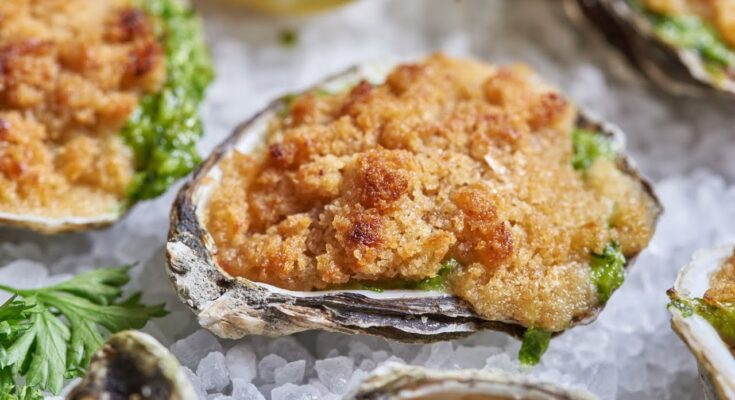Oysters Rockefeller Recipe: Oysters Rockefeller is one of those dishes that screams elegance. It dates back to the late 1800s in New Orleans, a city famous for its rich culinary traditions. Created at Antoine’s Restaurant in 1899, it was named after John D. Rockefeller—the wealthiest man in America at the time—because of the dish’s rich, buttery sauce. Unlike other oyster recipes that emphasize simplicity, Oysters Rockefeller embraces indulgence. Imagine briny oysters cradled in their shells, topped with a savory green mixture of herbs, butter, breadcrumbs, and sometimes cheese, all baked until bubbling and golden. It’s like an edible work of art.
Why It’s a Classic Appetizer
This dish isn’t just about luxury—it’s about flavor. Every bite is a mix of textures: the tender oyster, the creamy topping, the crispy breadcrumbs. It’s been a go-to starter at dinner parties, weddings, and upscale restaurants for over a century. But the best part? You can absolutely make it at home, and it’ll taste like you ordered it from a five-star bistro.
Ingredients You’ll Need
Freshness Is Key – Choosing the Right Oysters
When it comes to oysters, quality is everything. You want live, fresh oysters with tightly closed shells. If any are open and don’t close when tapped, toss them—they’re not safe to eat. East Coast oysters tend to be smaller and saltier, while West Coast ones are usually plumper and creamier. Either will work for this recipe, but it depends on your taste preference. Buying from a reputable fishmonger or seafood market ensures you’re getting top-notch shellfish.
Essential Ingredients List
Here’s what you’ll need for the full Oysters Rockefeller experience (makes about 12 servings):
- 12 fresh oysters, shucked and shells reserved
- 2 tablespoons unsalted butter
- 2 cloves garlic, minced
- 1 shallot, finely chopped
- 2 cups fresh spinach (or a mix of herbs like parsley, watercress)
- 1/4 cup breadcrumbs (Panko or Italian-style)
- 1/4 cup grated Parmesan cheese (optional but tasty)
- Dash of hot sauce (like Tabasco)
- Salt and freshly ground black pepper to taste
- Lemon wedges for garnish
- Rock salt or crumpled foil for stabilizing oysters in the baking dish
This combo balances savory, creamy, and zesty flavors. You can experiment a bit, but stick to the basics if it’s your first time.
Kitchen Tools and Equipment
Must-Have Tools for the Recipe
Don’t worry—you don’t need a commercial kitchen to pull this off. Just a few basics:
- Oyster knife: Essential for safely shucking the oysters.
- Sturdy gloves or a towel: To protect your hands while shucking.
- Baking sheet or oven-safe dish: For cooking the oysters.
- Skillet: For sautéing the topping mixture.
- Spoon or small spatula: To evenly distribute the topping.
Optional But Helpful Add-ons
While not required, these extras can make life easier:
- Rock salt or foil: This stabilizes the oyster shells while baking and makes for a pretty presentation.
- Food processor: For finely chopping spinach and herbs.
- Piping bag: If you want to make the topping look fancy.
Having everything prepped and ready makes the whole cooking process smooth and enjoyable.
Preparing the Oysters
How to Shuck Oysters Safely
Shucking oysters might sound intimidating, but it’s all about technique. First, place the oyster cup-side down on a towel. Grip it firmly with the towel to protect your hand. Insert the oyster knife into the hinge (the pointed end) and wiggle it until it pops open. Then slide the knife under the top shell to release the muscle. Be sure to keep the oyster liquor (the briny liquid inside) intact—that’s liquid gold!
Cleaning and Prepping for Cooking
Once you’ve shucked the oysters, rinse the bottom shells under cold water to remove any grit. Place each oyster back in its shell and onto a baking sheet lined with rock salt or foil. This helps keep them stable in the oven. Now you’re ready to take things to the next level: making the topping.
Making the Rockefeller Topping
Classic vs. Modern Ingredients
Traditionally, the topping was a secret blend of green herbs, butter, and breadcrumbs. Some purists avoid cheese altogether, while modern variations might include Pernod (an anise-flavored liqueur) or a touch of cream. Our recipe leans somewhere in the middle—faithful to the original but with some tasty upgrades.
Step-by-Step Topping Prep
- Sauté the aromatics: In a skillet, melt the butter over medium heat. Add the garlic and shallots. Sauté for about 2 minutes until fragrant.
- Add greens: Toss in the spinach (or herb mix). Cook until wilted—around 2–3 minutes.
- Blend for texture: Transfer the mixture to a food processor and pulse until finely chopped but not puréed.
- Add breadcrumbs and seasoning: Stir in breadcrumbs, Parmesan (if using), a dash of hot sauce, salt, and pepper. The mix should be moist but not soupy.
- Cool slightly: Let the mixture cool before topping the oysters—this makes it easier to handle.
This topping is what gives Oysters Rockefeller its signature richness. Once you’ve made it, you’re halfway there!
Assembling the Oysters Rockefeller
Layering the Topping Perfectly
Now that your oysters are prepped and your topping is ready, it’s time to assemble the dish. Start by scooping about a teaspoon of the Rockefeller topping onto each oyster. The key is to cover the oyster fully without overwhelming it. You want a nice mound on top that’s not spilling over.
Spread the topping gently using the back of a spoon or a small spatula. It should resemble a dome-like cover, sealing in the flavor. Some chefs like to add a tiny sprinkle of extra breadcrumbs or a pinch of Parmesan cheese for an extra crispy finish. This part is all about finesse—think gourmet, not sloppy!
Tips for Even Cooking
For even cooking, make sure all your oysters are lying flat and stable. Use rock salt or crumpled foil on your baking tray to create little nests that cradle each shell. This prevents any tipping and helps the topping cook evenly.
Preheat your oven to 450°F (230°C) before baking. You want that high heat to create a beautiful crust on the topping while gently warming the oyster underneath. Place the tray on the center rack and keep an eye on them—cooking time is short but critical.
Baking the Oysters to Perfection
Temperature and Timing Tips
Bake the oysters for about 8 to 10 minutes or until the topping starts to bubble and turn golden brown. The internal temperature should hit around 145°F (63°C) if you’re using a food thermometer. That ensures the oysters are cooked but not rubbery.
The high heat creates a beautiful contrast—crispy on top, soft and juicy underneath. If you’re making a large batch, consider broiling the last 1–2 minutes to get a slightly browned finish. But be careful not to overdo it—oysters are delicate and overcooking can ruin their texture.
Visual Cues for Doneness
Don’t just rely on time—your eyes are your best tools in the kitchen. Look for:
- Bubbling edges
- Golden-brown crust on top
- Slightly firm oysters beneath the topping
If you see any shells that tipped or spilled during baking, don’t stress. Just spoon the topping back in and serve with confidence.
Garnishing and Serving
Presentation Ideas
Oysters Rockefeller are stunning straight out of the oven, but a little garnish can elevate them even more. Try these ideas:
- Serve on a bed of rock salt or crushed ice on a platter to keep them steady and cool.
- Garnish with a lemon wedge on the side for a fresh, citrusy pop.
- Sprinkle chopped parsley or a tiny bit of paprika on top for color.
If you’re hosting a dinner party or holiday gathering, consider using a decorative platter or oyster tray to make your presentation Instagram-worthy.
Perfect Pairings – What to Serve With
Oysters Rockefeller pair beautifully with light, crisp flavors that balance their richness. Here are some perfect pairings:
- Drinks: Champagne, Sauvignon Blanc, or a dry Martini
- Sides: Fresh garden salad, crusty French bread, or a light soup
- Appetizers: Shrimp cocktail, deviled eggs, or smoked salmon bites
Think of this dish as your opener—it sets the tone for the rest of the meal, so keep the vibe elegant and light.
Storage and Reheating Tips
Best Practices for Leftovers
While Oysters Rockefeller are best enjoyed fresh, you can store leftovers in the fridge for up to 2 days. Just make sure they’re tightly wrapped or in an airtight container. Don’t store them in the shell if possible—transfer to a small baking dish.
You can also freeze the assembled (but unbaked) oysters. Lay them on a tray, freeze until solid, then store in a freezer bag for up to 1 month. Bake from frozen, adding 2–3 extra minutes of cook time.
What to Avoid
Avoid microwaving cooked oysters. It tends to make them rubbery and ruins the texture of the topping. Instead, reheat in a preheated oven at 350°F (175°C) for 5–7 minutes until warmed through.
And never reheat more than once—oysters are delicate, and multiple reheats can lead to food safety risks and a sad, soggy topping.
Common Mistakes to Avoid
Even seasoned cooks can make a few missteps with Oysters Rockefeller. Here’s what to watch out for:
- Overcooking the oysters: Keep an eye on your oven. Once they start bubbling, they’re usually done.
- Using old oysters: Freshness matters. Only use live oysters with tightly closed shells.
- Too much topping: It can overpower the oyster. Balance is key.
- Skipping the salt bed: Oysters need a stable base. If they tip, you lose all the good stuff.
- Not drying the shells: Wet shells can make the topping soggy and lead to uneven baking.
Learn from these common mistakes and you’ll nail this dish every single time.
Health Benefits of Oysters
Oysters aren’t just delicious—they’re also packed with nutrients that are fantastic for your body. When enjoyed in moderation and cooked safely, they can be part of a healthy, balanced diet.
1. Rich in Protein: Oysters are a great source of lean protein. One serving of oysters can give you around 8–10 grams of protein, which helps in building and repairing tissues.
2. High in Zinc: One of the most impressive benefits? Their zinc content. Oysters have more zinc than almost any other food. Zinc is essential for immune health, wound healing, and even enhancing libido.
3. Loaded with Vitamins and Minerals:
They’re full of essential nutrients like:
- Vitamin B12 – for brain health and red blood cell production.
- Iron – which helps transport oxygen in the blood.
- Selenium – an antioxidant that protects your cells from damage.
4. Low in Calories and Fat: Despite their rich, briny flavor, oysters are naturally low in calories and fat, especially when not fried or drenched in heavy sauces.
5. Heart-Healthy: Oysters contain omega-3 fatty acids, which are known for supporting heart health by reducing blood pressure and cholesterol levels.
Just remember, because they’re high in sodium and cholesterol, moderation is key—especially if you have dietary restrictions. Always enjoy oysters as part of a wider, well-rounded eating plan.
FAQs about Oysters Rockefeller Recipe
1. What are the key ingredients in Oysters Rockefeller?
The essential ingredients for Oysters Rockefeller include fresh oysters, butter, parsley, green onions, garlic, breadcrumbs, and Parmesan cheese. Seasonings like salt, pepper, and a dash of Pernod or anise-flavored liqueur are also commonly used to enhance the flavor.
2. How do you prepare the oysters for cooking?
Begin by thoroughly rinsing the oysters under cold water to remove any debris. Shuck the oysters, keeping them on the half shell and retaining as much of their liquor (natural juice) as possible. Place them on a bed of rock salt in a baking tray to stabilize them.
3. What is the best way to cook Oysters Rockefeller?
Oysters Rockefeller are typically baked or broiled. Preheat your oven to 450°F (232°C) for baking, or set it to broil to cook the oysters closer to the heat source. Spoon the prepared topping on each oyster and cook for about 10 minutes or until the edges of the oysters curl slightly and the topping is bubbly and golden.
4. Can Oysters Rockefeller be made ahead of time?
Yes, you can prepare Oysters Rockefeller ahead of time. Assemble the oysters with the topping on the half shell and refrigerate them for up to a day before you plan to bake or broil them. This makes it a convenient dish for entertaining.
5. Are there any good substitutes for Pernod in the recipe?
If Pernod is unavailable or you prefer not to use alcohol, you can substitute it with non-alcoholic anise extract, or simply omit it. Some recipes use other herbs like tarragon or fennel to mimic the anise flavor.
6. How do I serve Oysters Rockefeller?
Serve Oysters Rockefeller immediately after cooking while they are hot. They are typically presented on the half shell, garnished with lemon wedges and additional chopped parsley. Oysters Rockefeller makes a luxurious starter or an impressive addition to a seafood platter.
Final Thoughts
Once you’ve mastered the basic steps—shucking, topping, and baking—you’ll find endless ways to customize it. Add bacon bits, switch up the herbs, or try it with different cheeses. It’s one of those dishes where a little creativity goes a long way.
So, next time you’re hosting a dinner or craving something gourmet, go ahead and serve up some Oysters Rockefeller. Trust me—your guests (and your taste buds) will thank you.



